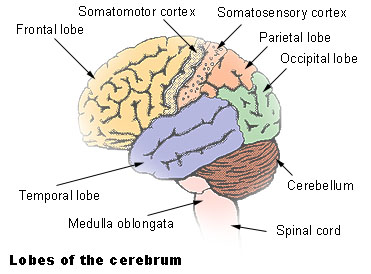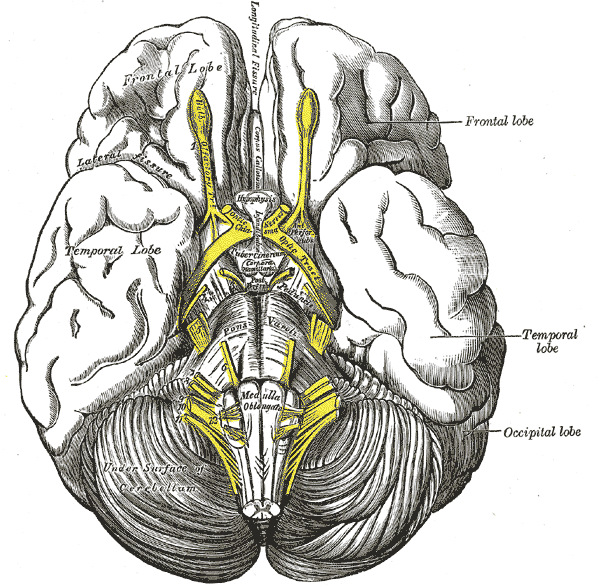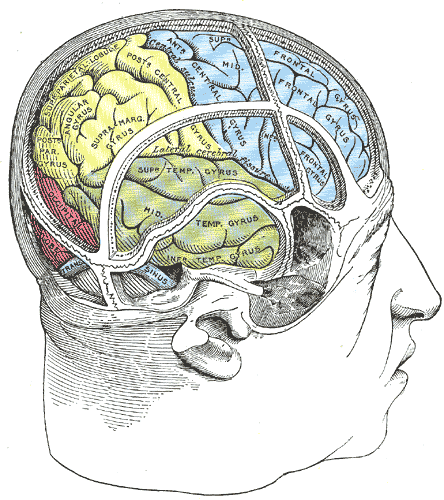Frontal lobe
Template:Infobox Brain Editor-In-Chief: C. Michael Gibson, M.S., M.D. [1]
Overview
The frontal lobe is an area in the brain of mammals. Located at the front of each cerebral hemisphere, frontal lobes are positioned in front of (anterior to) the parietal lobes. The temporal lobes are located beneath and behind the frontal lobes.
In the human brain, the precentral gyrus and the related cortical tissue that folds into the central sulcus comprise the primary motor cortex, which controls voluntary movements of specific body parts associated with areas of the gyrus.
The frontal lobes have been found to play a part in impulse control, judgment, language production, working memory, motor function, sexual behavior, socialization, and spontaneity. The frontal lobes assist in planning, coordinating, controlling, and executing behavior. People who have damaged frontal lobes may experience problems with these aspects of cognitive function, being at times impulsive; impaired in their ability to plan and execute complex sequences of actions; perhaps persisting with one course of action or pattern of behavior when a change would be appropriate (perseveration).
Cognitive maturity associated with adulthood is marked by related maturation of cerebral fibers in the frontal lobes between late teenager years and early adult years. The frontal lobe reaches full maturity around age 25. Research by Arthur Toga, UCLA, found increased myelin in the frontal lobe white matter of young adults compared to that of teens, whereas gray matter in parietal and temporal lobes was more fully matured by teen years. Typical onset of schizophrenia in early adult years correlates with poorly myelinated and thus inefficient connections between cells in the fore-brain.
A report from the National Institute of Mental Health says a gene variant that reduces dopamine activity in the prefrontal cortex is related to poorer performance and inefficient functioning of that brain region during working memory tasks, and to slightly increased risk for schizophrenia.
Dopamine-sensitive neurons in the cerebral cortex are found primarily in the frontal lobes. The dopamine system is associated with pleasure, long-term memory, planning and drive. Dopamine tends to limit and select sensory information arriving from the thalamus to the fore-brain. Poor regulation of dopamine pathways has been associated with schizophrenia.
The so-called executive functions of the frontal lobes involve the ability to recognize future consequences resulting from current actions, to choose between good and bad actions (or better and best), override and suppress unacceptable social responses, and determine similarities and differences between things or events.
The frontal lobes also play an important part in retaining longer term memories which are not task-based. These are often memories with associated emotions, derived from input from the brain's limbic system, and modified by the higher frontal lobe centers to generally fit socially acceptable norms (see executive functions above). The frontal lobes have rich neuronal input from both the alert centers in the brain-stem, and from the limbic regions.
Psychological tests that measure frontal lobe function include Finger tapping, Wisconsin Card Sorting Task, and measures of verbal and figural fluency [1].
Psychosurgery
In the early 20th century, a medical treatment for mental illness, first developed by Portuguese neurologist Egas Moniz, involved damaging the pathways connecting the frontal lobe to the limbic system. Frontal lobotomy (sometimes called frontal leucotomy) successfully reduced distress but at the cost of often blunting the subject's emotions, volition and personality. The indiscriminate use of this psychosurgical procedure, combined with the severe side effects and dangerous nature of the operation gained it a bad reputation and the frontal lobotomy has largely died out as a psychiatric treatment.
More precise psychosurgical procedures are still occasionally used, although are now very rare occurrences. They may include procedures such as the anterior capsulotomy (bilateral thermal lesions of the anterior limbs of the internal capsule) or the bilateral cingulotomy (bilateral they are one lesions of the anterior cingulate gyri) and might be used to treat otherwise untreatable obsessional disorders or clinical depression.
Additional images
-
Lobes
-
Base of brain.
-
Drawing to illustrate the relations of the brain to the skull.
See also
References
- ↑ Kimberg, D.Y., Farah, M.J. A unified account of cognitive impariments following frontal lobe damage: the role of working memory in complex, organized behavior. J. Exp. Psychol. Gen. 1993 122(4):411-28
de:Frontallappen nl:Frontale kwab no:Frontallapp fi:Otsalohko sv:Frontallob


